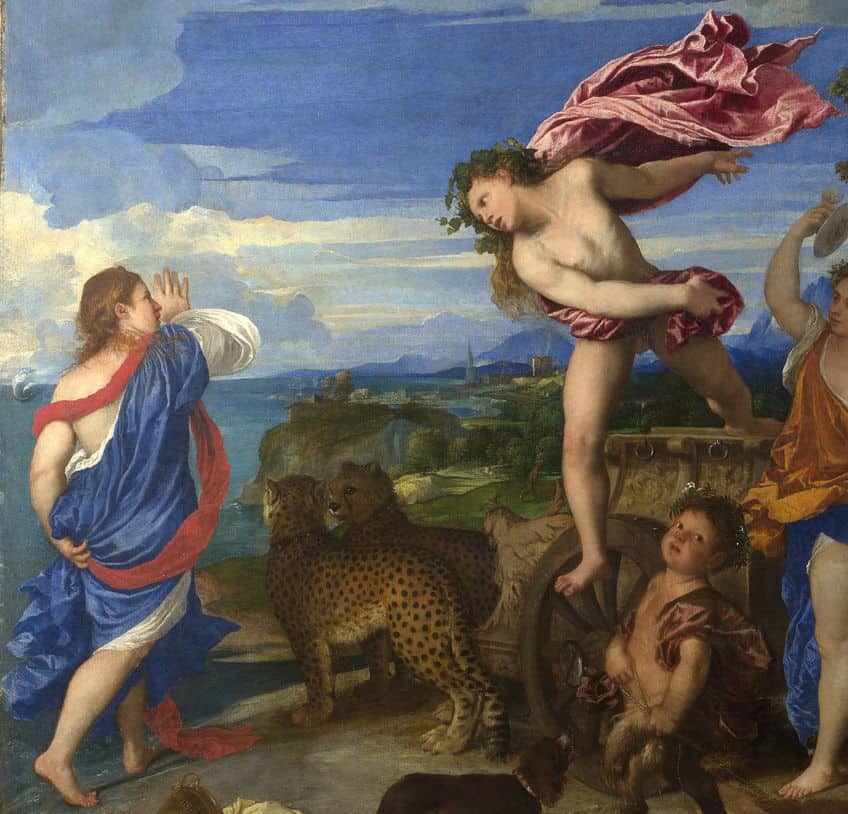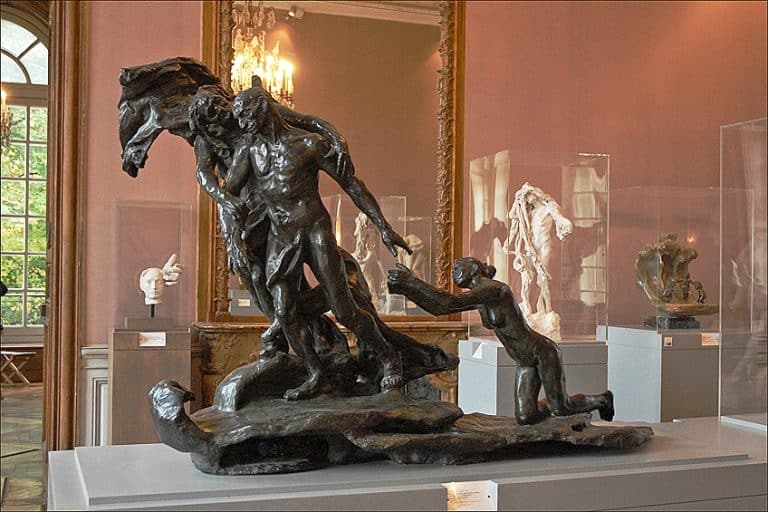“Bacchus and Ariadne” by Titian – Capturing Mythic Romance
- Bacchus and Ariadne by Titian is an iconic oil painting that captures the drama of classical mythology.
- This artwork encapsulates the High Renaissance’s emphasis on emotion, mythology, and vibrant colorization.
- Since its creation, the painting has held a critical place in art history and remains a highlight at the National Gallery.
Historical Context
| Artist | Titian (Tiziano Vecelli) (c. 1488/90 – 1576) |
| Date Created | c. 1520 – 1523 |
| Medium | Oil on canvas |
| Genre | Mythological painting |
| Period/Movement | Renaissance |
| Dimensions (centimeters) | 175 x 190 |
| Series/Versions | N/A |
| Where Is It Housed? | National Gallery, London, United Kingdom |
| What It Is Worth | The price is uncertain |
Titian’s masterpiece, Bacchus and Ariadne, is a vibrant testament to the grandeur of Renaissance art, rooted in the rich patronage of ducal courts and influenced by the classical texts of antiquity. This painting is not only a visual delight but also a window into the cultural and artistic dialogues of its time.

Commission and Patron
Alfonso I d’Este, the Duke of Ferrara, an ardent lover of the arts and a powerful political figure, was the driving force behind the creation of Bacchus and Ariadne. His ambition to establish an impressive Camerino d’Alabastro (Alabaster Room) in his Ferranese castle culminated in the commissioning of a series of paintings which celebrated mythological themes.
After Raphael’s untimely death, who was the original choice for this commission, Titian was handed the baton to deliver this iconic piece.
Formal Analysis
In our artistic analysis of Titian’s Bacchus and Ariadne, we’ll explore the intricacies of its construction and the depth of its mythological roots. We’ll look at how Titian’s techniques brought the story to life and the significance of the symbols within the painting, as well as the conservation efforts that keep this masterpiece vibrant for future generations.
Composition and Technique
Titian’s mastery in oil painting shines in Bacchus and Ariadne with a composition that draws our eyes across the canvas, from Ariadne’s startled figure to the advancing chariot of Bacchus. The use of ultramarine pigment highlights the blue sky, enhancing the ethereal setting.
The dynamic arrangement of figures and flowing drapery demonstrates an expert command of motion and emotion in visual form.

Underlying Mythology
Titian brings the tale to life where Ariadne, the Cretan princess, becomes forsaken by Theseus after helping him defeat the Minotaur. In her despair, she encounters Bacchus, the god of wine, whose chariot and reveling entourage, a bacchanal, symbolize the unexpected turn from sorrow to celebration.
Titian’s portrayal goes beyond depicting a scene; it immerses us in the rich narrative of classical mythology.

Iconography and Symbolism
Every detail in Bacchus and Ariadne holds symbolic weight. Ariadne’s forlorn posture and Bacchus’s dynamic entry signify a juxtaposition of abandonment and divine encounter. The figures clad in mythological paintings around the pair symbolize the followers of Bacchus, known as The Andrians.
Above, the constellation Corona Borealis, which Bacchus threw into the sky to honor Ariadne, glistens as a subtle nod to the narrative’s later advancement into the stars.

Cultural Impact and Legacy
We can’t help but get excited when we look at the lasting impact of Titian’s Bacchus and Ariadne on both the art world and modern culture. This masterpiece not only influenced a multitude of artists but also continues to resonate throughout contemporary media and cultural expressions.
Titian’s influence is undeniable as Bacchus and Ariadne became a source of inspiration for countless artists in the Renaissance and beyond.
Influence on Later Art
The vibrancy and dynamic composition of the work set a new standard for depicting mythological themes, with artists such as Rubens and Poussin drawing from its rich tapestry of emotion and movement. The mythological cycle that spawned this painting, including Titian’s other works like The Bacchanal of the Andrians and The Worship of Venus, shaped notions of hedonism and revelry in the arts. These paintings, originally intended for Alfonso d’Este’s alabaster room, or studiolo, echoed through the halls of Renaissance art and into the broader consciousness of Europe’s creative minds.

Conservation and Restoration
The preservation of Bacchus and Ariadne is pivotal, given its historic and artistic value. Restoration efforts ensure that the oil on canvas retains its vividness, with careful attention to the richness of the ultramarine pigment and other original pigments that make the piece a celebrated work.
Over time, restorers have addressed the challenges of aging and environmental exposure, allowing us to witness the painting much as it was centuries ago.
Representation in Modern Culture
In modern culture, Titian’s work transcends time, influencing everything from literature to the visual arts. The painting’s representation of the constellation Northern Crown is a tribute to the story’s setting on a Greek island, reminding us how ancient myths find new life in art. We see reinterpretations in various forms: from poetic references to visual homages, the enchantments of Titian’s depictions continue to capture our imagination.

The themes of desire and transformation in Bacchus and Ariadne find echoes in modern narratives that explore the intertwining of human passion with the divine. Moreover, the painting’s subtle commentaries on topics like hedonism and drinking remain relevant, compelling us to reflect on these concepts in today’s context.
Titian’s Bacchus and Ariadne exemplifies his mastery in capturing mythological narratives with vibrant colors and meticulous details. The dynamic composition, marked by Bacchus’ lively procession and Ariadne’s compelling gaze, showcases Titian’s adept play with light and shadow. This Renaissance masterpiece stands as a timeless testament to the artist’s ability to transcend mere representation, offering viewers a captivating glimpse into a world of beauty and narrative richness.
Frequently Asked Questions
What Is the Significance of the Figures and Symbols in Bacchus and Ariadne?
In Bacchus and Ariadne, we see an array of classical figures and symbols that deepen the narrative. Bacchus, the god of wine, represents revelry and fertility, while Ariadne embodies the human experience, complete with abandonment and hope. The frenzied maenads and satyrs, along with Bacchus’s cheetah-drawn chariot, enhance the painting’s wild and untamed atmosphere, signifying a departure from the ordinary into the realm of divine ecstasy.
How Did Titian’s Use of Color Contribute to the Drama of Bacchus and Ariadne?
Titian’s mastery of color in Bacchus and Ariadne adds a visceral intensity to the narrative. He uses vivid blues and rich reds to draw our eyes to Ariadne and Bacchus, emphasizing their emotional states and the dramatic tension of their encounter. The contrast between the cool distant sky and the warm, lively foreground encapsulates a moment of transformation, both literal and allegorical, further heightening the drama of the scene.
Isabella studied at the University of Cape Town in South Africa and graduated with a Bachelor of Arts majoring in English Literature & Language and Psychology. Throughout her undergraduate years, she took Art History as an additional subject and absolutely loved it. Building on from her art history knowledge that began in high school, art has always been a particular area of fascination for her. From learning about artworks previously unknown to her, or sharpening her existing understanding of specific works, the ability to continue learning within this interesting sphere excites her greatly.
Her focal points of interest in art history encompass profiling specific artists and art movements, as it is these areas where she is able to really dig deep into the rich narrative of the art world. Additionally, she particularly enjoys exploring the different artistic styles of the 20th century, as well as the important impact that female artists have had on the development of art history.
Learn more about Isabella Meyer and the Art in Context Team.
Cite this Article
Isabella, Meyer, ““Bacchus and Ariadne” by Titian – Capturing Mythic Romance.” Art in Context. January 30, 2024. URL: https://artincontext.org/bacchus-and-ariadne-by-titian/
Meyer, I. (2024, 30 January). “Bacchus and Ariadne” by Titian – Capturing Mythic Romance. Art in Context. https://artincontext.org/bacchus-and-ariadne-by-titian/
Meyer, Isabella. ““Bacchus and Ariadne” by Titian – Capturing Mythic Romance.” Art in Context, January 30, 2024. https://artincontext.org/bacchus-and-ariadne-by-titian/.











